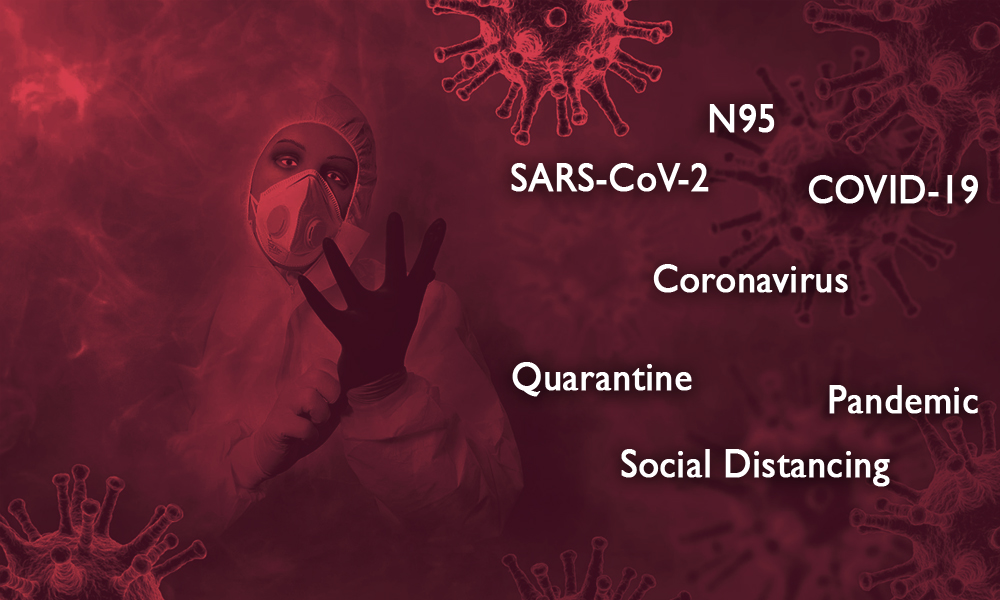
Image Source: Pixabay
Coronavirus Lockdown: Key Terms You Should Know
India, 27 March 2020 5:54 AM GMT | Updated 27 March 2020 8:59 AM GMT
Editor : Shubhendu Deshmukh |
Shubhendu, the quint essential news junky, the man who loves science and politics in equal measure and offers the complete contrast to it by being a fan of urdu poetry as well.
Written By : Zoya Hussain
A freelance contributor based in Delhi. Also, a journalism student at Jamia Millia Islamia. I write and report on areas that remain untouched to deliver worthwhile contribution.
As the new coronavirus spreads around the world, a host of new terms are entering the dictionary.
The coronavirus outbreak that started from Wuhan, China has now gripped over 170 nations. On March 11, 2020, the World Health Organisation (WHO) declared the coronavirus outbreak a 'global pandemic'. But to many, terms such as global pandemic/pandemic COVID-19, and NCoV-19, are still new.
As the new coronavirus spreads around the world, a host of new terms are entering the dictionary. Despite all of them being a group of completely unfamiliar words, some are new while some are old terms but are used in unexpected ways. Understanding these terms becomes essential as the wrong usage of any of the term could lead to confusion and uncertainty. Here's a guide to the words, along with some context you need to know to keep informed of the latest developments.
COVID-19/ NCoV-19:
The disease that started being referred to as the "Wuhan virus" to "Wuhan coronavirus" and "China coronavirus," and subsequently 2019-nCoV. Eventually, on 11 Feb 2020, the World Health Organization (WHO) gave the disease an official name: COVID-19, using letters from CO-rona-VI-rus D-isease 2019. A coronavirus is a group of viruses that got its name from its appearance. The virus resembles the sun's corona, in which crown-like spikes protrude from its surfaces that are visible during a solar eclipse. It's a disease caused by one type of coronavirus: SARS-CoV-2.
SARS-CoV-2:
SARS-CoV-2 is the technical name for the novel strain of coronavirus and stands for Severe Acute Respiratory Syndrome Coronavirus 2. The virus causes illness ranging from the common cold to more severe diseases, such as Middle East Respiratory Syndrome and Severe Acute Respiratory Syndrome (SARS-CoV).
SARS elucidates that the illness causes a possibly severe, abrupt but temporary (intense) disease which affects the respiratory system.
Pandemic:
Pandemic is an outbreak that has spread over multiple countries/continents or across the globe, affecting a large number of people. In the case of COVID-19, it is now defined as a "worldwide spread" of this new disease. On March 11, 2020, WHO officially declared the novel coronavirus outbreak a 'global pandemic' phenomenon. It is noted that COVID-19 is at "alarming levels of spread and severity". The word can be both a noun and an adjective (e.g., a pandemic disease). As per authorities, such a statement doesn't necessarily mean that the disease is any deadlier, simply more prevalent. The last pandemic was the H1N1 or Swine Flu outbreak in 2009 that took over 18,000 lives.
Quarantine:
The word is extensively used by news organisations, governments and the WHO. Another similar word that has been used frequently is self-quarantine, that means voluntarily or willingly restricting their movement in virus-hit regions. According to C.D.C, those who seem to see COVID-19 symptoms or had travelled earlier must separate themselves usually for at least 14 days as they may be potentially exposed to the virus.
Social Distancing:
The most effective way to control the spread of contagious disease is by cutting off oneself socially. Social distancing here refers to limiting person-to-person interaction as much as possible. Avoid public places like offices, gym, club, restaurants, shopping complex and all sort of public transport where there is a high probability of transmission. At the community level, it usually means closing schools, workplaces, cancelling events, concerts or any huge number of gatherings. For individuals, it means maintaining six feet of distance between each other while in public and avoiding physical contact with people.
Incubation Period:
The period from an individual being exposed/infected with a pathogen, such as a virus, to showing first signs of symptoms related to the disease. The WHO finding confirms that most patients who become COVID-19 symptomatic do so within 11 or 12 days and the vast majority within 14 days. Hence, people who are travelling or show any COVID-19 symptoms are advised to quarantine for a minimum of 14 days to avoid further spread of the disease.
R0-Number:
It is usually referred to as R-naught or R0. To understand the possibility, an epidemiologic metric is used to describe how contagious and infectious disease is. R0 is a virus's basic reproductive number--transmissibility of infectious agents. The number helps in finding the average number of people who will be affected by one contagious person. R0 value possibly applies when everyone in a population is entirely vulnerable to the disease. This means, none among the population has been vaccinated, has had the disease before and there's no way to control the spread of the disease. The MRC Centre for Global Infectious Disease Analysis at Imperial College London has estimated the COVID-19 has an R0 between 1.5 and 3.5.
N95:
N95 respirators and masks are personal protective equipment from the new coronavirus disease. Centres for Disease Control and Prevention (CDC) updated guidance for healthcare workers who are treating possible COVID-19 patients in conventional, contingency, and crisis settings. In N95, N-stands for 'not oil-resistant' while 95-indicates the percentage of particles (which have a diameter of at least 0.3 microns) which the mask can filter out. It is the most common mask used to prevent flu and influenza. These masks are designed to fit over the nose with the help of a clip and mouth of the wearer. It is advisable to wear an N95 mask if you are coughing/sneezing or taking care of a person with suspected COVID-19 infection.
Also Read: Good To Know: Here Is How Isolation And Quarantine Are Different
 All section
All section














